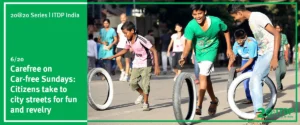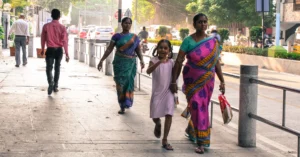All global metropolitans, including Indian ones, are waking to the realisation that it is imperative to prioritise walking and cycling while planning cities. To quote placemaking pioneer Fred Kent, “If you plan cities for cars and traffic, you get cars and traffic. If you plan for people and places, you get people and places.”
“With over 100 km of streets reclaimed for pedestrians and cyclists, Chennai is certainly on the right track of prioritising people over motorised transport,” said L Nandakumar, chief engineer of the Greater Chennai Corporation, while presenting various street transformations and laurels the city has achieved over the years.
The need for an NMT master plan was highlighted by Aswathy Dilip, Senior Programme Manager at the ITDP India Programme, who spoke of the requirement for bringing a network approach in the planning of projects in the city. This will help scale up the existing projects, ensuring the street transformations are not scattered and instead done in a holistic manner. An NMT master plan will ensure the promotion of environmentally friendly modes that encourage healthy lifestyles. It will also contribute to social equity by improving accessibility to work and home for all cross sections of the society.
The proposed approach for the Chennai NMT master plan is in line with the Tamil Nadu Mega Streets Programme, that plans to redesign 1,600 km of roads across ten corporations in the state.
Chennai Street Design Guidelines
Over the past few years, Chennai has been taking great efforts to create safe, walkable, and livable streets that cater to all user groups. Known as Complete Streets, these are designed with wide and continuous footpaths, safe pedestrian crossings, dedicated cycle tracks (where applicable), conveniently placed bus stops, clearly designated on-street parking, organised street vending, and properly-scaled carriageways.
With many more streets in the pipeline to be redesigned by the Greater Chennai Corporation, the NMT master plan looks to drive this vision through with a set of guidelines to direct the design and implementation process. The main focus being to improve the user experience and ensure seamless connectivity. As a result, the state is planning to adopt the Chennai Street Design Guidelines—which draws from various Indian Roads Congress guidelines and also from the city’s own learnings from its street design experience.
The guidelines aim to create streets for all users. It is intended for urban designers and most importantly, government officials and citizens who look to inhabit better quality urban environment and bring back life into our city streets. For this purpose, the design guide identifies the different functions of streets and emphasises the need for complete streets that accommodates all.
Besides the step-by-step design process chart, the guidelines offer designers a checklist of information to be collected prior to designing the street. It also highlights the various elements that form a complete street. Through street and intersection templates, one can get a sense of how different elements come together to create different types and sizes of streets.
Hands-on Exercise
To better understand the concept of Complete Streets, the engineers, at the workshop, were engaged through a hands on exercise to use the guidelines to redesign a city stretch. As interest grew in the exercise so did the valuable feedbacks, which have been noted and the ITDP India Programme will work to improve suitably.







